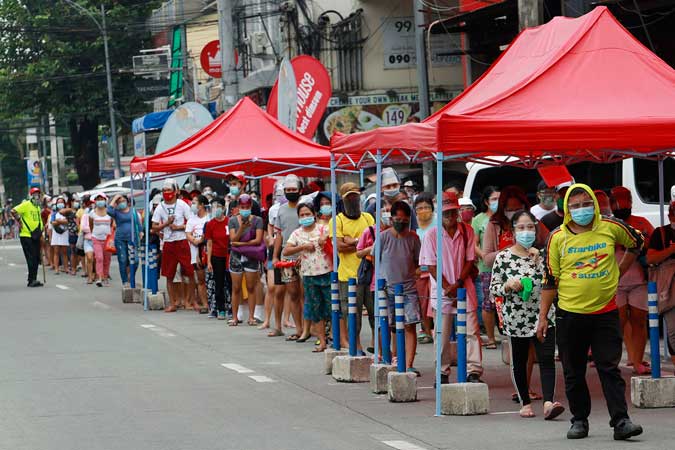PEOPLE line up to get free food supplies from a community pantry in Quezon City, April 26. — PHILIPPINE STAR/ MICHAEL VARCAS
THE COUNTRY’S jobless rate in March fell to its lowest level since the start of the coronavirus pandemic, the Philippine Statistics Authority (PSA) reported on Thursday.
Preliminary results of the PSA’s March 2021 round of the Labor Force Survey (LFS) showed around 3.441 million unemployed Filipinos, down from 4.187 million and 3.953 million in the February and January LFS rounds, respectively.
This puts the March unemployment rate at 7.1%, the lowest since the 5.3% in January 2020, as well as the record-high 17.6% posted in April 2020.
The underemployment rate — the proportion of those already working but still looking for more work or longer working hours — improved to 16.2% in March from 18.2% in February.
This translates to 7.355 million underemployed Filipinos, less than the 7.850 million in February. However, this was higher than the 6.589 million recorded in the January LFS round.
The size of the labor force was approximately 48.772 million in March, up from 47.341 million in February and 45.201 million in January. This brought the labor force participation rate (LFPR) to 65% in March, the highest since the 65.2% posted in April 2014.
The employment rate — the proportion of the employed to the total labor force — was recorded at 92.9% in March. This was higher than the 91.2% rate in February. In absolute terms, this was equivalent to 45.332 million in March versus 43.153 million in February — or a net job creation of 2.178 million during the period.
The employment rate in the service sector declined to 56% in March from 58.4% in February. On the other hand, those in agriculture and industry, increased to 24.6% (from 23.9%) and 19.4% (from 17.7%), respectively.
Among subsectors, construction posted the largest increase in employment on a month-on-month basis with 845,543, followed by wholesale and retail trade with 672,144 and agriculture and forestry with 623,481.
Meanwhile, education saw the largest drop (247,879), followed by transportation and storage (194,321) and “other service activities” (149,241).
Comparing March performance with February, there were 1.155 million jobs restored in the industry sector during that period, followed by 826,698 jobs in agriculture, and 196,740 in services.
Working hours averaged 39.7 a week, higher the average of 38.9 in February.
Full-time workers, or those who worked for at least 40 hours a week, made up 62.2% of the total employed in March. This was higher than 59.9% in the previous month.
Meanwhile, part-time workers made up 36.7% of the employed, down from 38.5% previously.
LOCKDOWN EFFECT
“With the recovery of the economy after the ECQ was relaxed in mid-2020, 11.5 million jobs have been generated as of March 2021, more than offsetting the 8.7 million jobs that were lost in the period March to May 2020. This translates to a net job creation of 2.8 million jobs,” Socioeconomic Planning Secretary Karl Kendrick T. Chua, Finance Secretary Carlos G. Dominguez III, and Budget and Management Secretary Wendel E. Avisado said in a joint statement.
The PSA noted the LFS was conducted between March 8 to 27, days before the government put Metro Manila, Bulacan, Rizal, Laguna, and Cavite on the enhanced community quarantine (ECQ) — the strictest form of lockdown — in reaction to a renewed surge in coronavirus cases.
The government has imposed lockdown restrictions since March last year to curb the spread of COVID-19 (coronavirus disease 2019). From March 29 to April 11 this year, Metro Manila and the provinces of Bulacan, Cavite, Laguna, and Rizal were placed under ECQ. The areas are currently under a less restrictive modified enhanced community quarantine (MECQ) until May 14.
The economic managers expect to see a “temporary reversal” of employment gains in the LFS round for April given the imposition of ECQ and MECQ in Metro Manila and nearby provinces. They, however, said the impact is expected to be “less severe” compared with that of April 2020 given the government’s “more risk-managed approach to present quarantines.”
“Unlike last year’s ECQ and MECQ where around three-fourths of the economy was shut down, most sectors of the economy, including public transport, this time around are allowed to operate subject to guidelines from the Inter-Agency Task Force on the Management of Emerging Infectious Diseases,” they said.
In a separate statement, Labor Secretary Silvestre H. Bello III said the results are “encouraging.”
“Our economy is gradually getting back on track as more people are actively participating in the labor force and are becoming employed,” he said.
In a Viber message, Security Bank Corp. Chief Economist Robert Dan J. Roces said the gradual reopening of the economy played “some part” in the March LFS results. However, he noted the results show an “uneven recovery and deep scarring effects” with other sectors continuing to decline despite the reopening.
In an e-mail, University of the Philippines Professor Emeritus Rene E. Ofreneo said while more Filipinos are entering the labor force, the jobless rate of 7% is still “relatively high.”
“Job creation is not reducible to a question of ‘opening up the market,’ or going back to the ‘old normal.’ The world has changed and we have to adjust to it,” he said.
Asked for his outlook on the jobs situation, Mr. Ofreneo said “only a miracle” can ease unemployment further in April given the implementation of stricter lockdowns. He also cited April as the month where most senior high students and college graduates join the labor force, thus increasing the demand to find jobs. — Ana Olivia A. Tirona with inputs from Gillian M. Cortez and Beatrice M. Laforga

